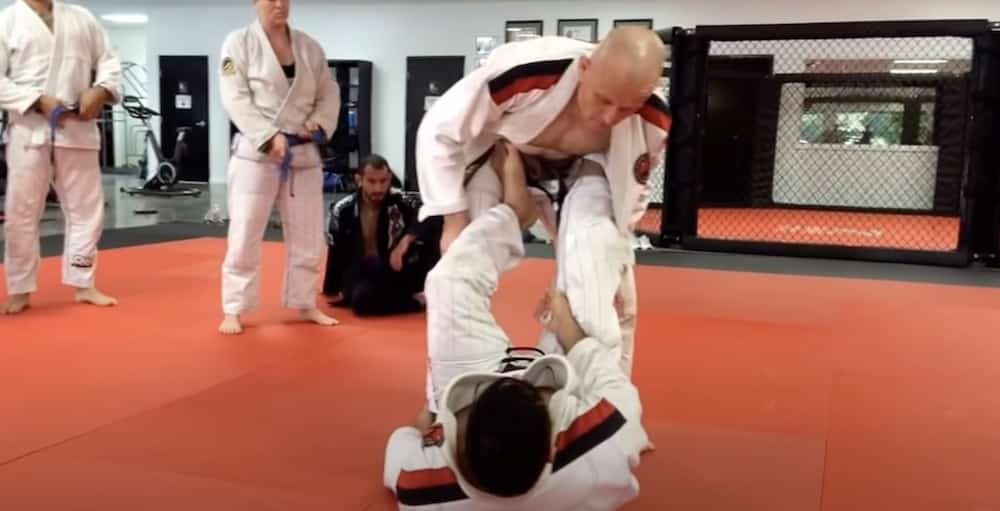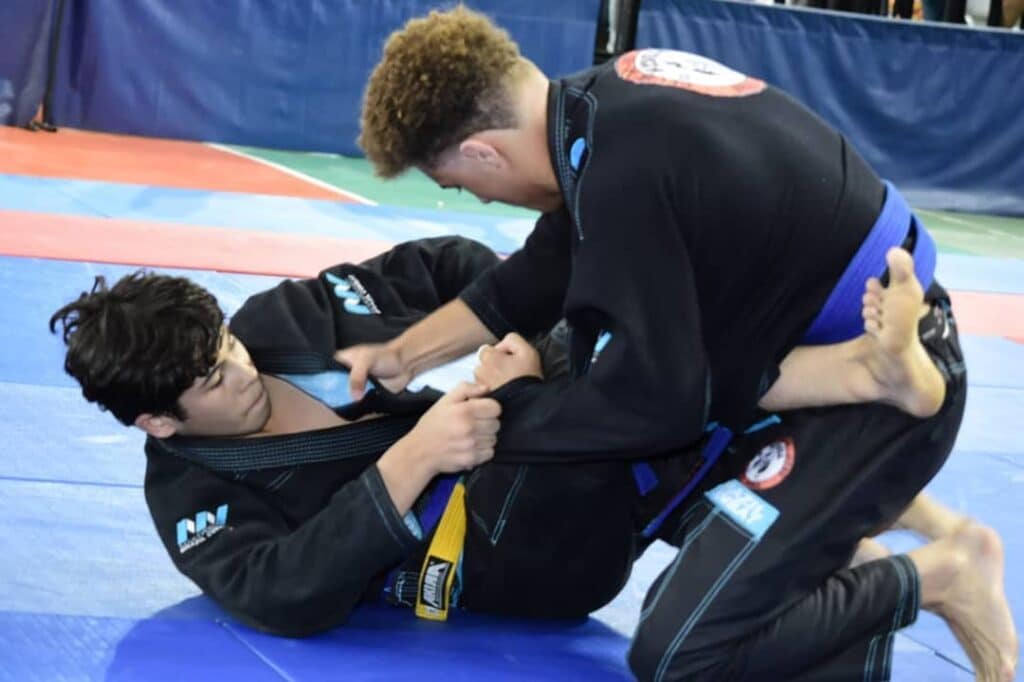Worm Guard – BJJ Technique Explained

It is incredible how the guard in BJJ has evolved in the last few decades. Going from closed guard, open guard, spider guard, and then lapel guard.
Then from lapel guard it has evolved to another highly technical guard system known as the worm guard. One of the newest and effective guards that has come on the Jiu Jitsu scene.
It’s been met with a little controversy, but it’s effectiveness cannot be questioned. Let’s take a deeper look at the worm guard and detail a little of the guard’s history. After that, we’ll go over how to use the worm guard and tips for using it.

Who came up with the worm guard?
The worm guard was developed by multiple time BJJ champion Keenan Cornelius. Keenan is known for being one of the most innovative grapplers in BJJ.
He is known as a highly effective guard player that is always trying to adapt moves to his style. What he is most known for is developing his signature worm guard.
Keenan began developing his guard, when he was training under André Galvão at Atos BJJ. Galvão actually helped Keenan name the guard after Keenan asked him to describe the guard. Stating that it was “like fighting a worm.”
The first time the BJJ public saw Cornelius use the guard was at the 2014 Pans Championship against Murilo Santana. Down on points and dealing with Santana’s heavy pressure, Keenan decided to test his worm guard in action.
It was proven to be rather effective in controlling his opponent and helped him come back to win the match. Keenan would begin using it with more success at his next few competitions.
But there were some who weren’t fans of his new guard and considered it stalling. One of those was a Brazilian Jiu Jitsu promotion called Copa Podio. They actually banned the move for a short time, but quickly unbanned it after backlash from the BJJ community.
Today, Keenan is still adding on to his worm guard, as well as other high level grapplers that have adopted it.
How does the worm guard work?
The whole reason Keenan developed the worm guard was to establish complete control over his opponent’s. When you control your opponent’s lapel, you can control their movement and posture, while also forcing them to turn.
With their posture and movement controlled, this leaves you open to hit sweeps and submissions. This is why Keenan decided to develop the worm guard.
To further control his opponent with their lapel, he will lace it through his legs and their legs. This weaving of the opponent’s lapel makes it look similar to a worm slithering between you and your opponent. Hence the name, the worm guard.
Basic worm guard setup
You can set up the worm guard from almost every guard and even from a guard pull. Let’s say you’re starting from a De La Riva guard and you have control of your opponent’s lapel.
Your first step is to keep your foot on your opponent’s same side hip. If you don’t keep your foot on their hip, there is almost nothing stopping them from passing.
Next is the steps you need to go through to pass their lapel to your other hand. The opponent’s lapel needs to pass under your inside leg, otherwise you have a sit-up guard.
To be able to pass the lapel, you need to kick your DLR hook leg up, so you can sit-up. If you stay on your back, you won’t be able to pass the opponent’s lapel.
Once you pass their lapel, pull down on it to keep tension and sit on your side.
5 worm guard sweep variations
There are numerous ways to sweep your opponent from the worm guard, but here are 5 effective sweeps from the guard.
1. DLR worm sweep to berimbolo
If you know how to do the classic DLR sweep to a berimbolo roll, this is exactly the same. You’re just controlling your opponent’s lapel for extra control.
Start by passing your opponent’s lapel back to your inside hand. Then grab the opponent’s ankle, stretch your leg in between their legs, and hook their far hip.
Now with all these points controlled, sweep your opponent backwards like in the classic DLR sweep. Then if you so wish, you can berimbolo roll to take your opponent’s back.
2. DLR worm sweep to the side
Same setup as the last sweep with your worm grip and hooking your opponent’s hip. But this time they step to the side to defend the back sweep.
Now you’re going to cross grab your opponent’s sleeve and pull it towards you as you stretch your DLR hook. They fall to the side and you sit up on top.
3. Worm sit-up sweep
This is the same setup as the classic sit-up guard sweep, but with a worm grip on the lapel. With the opponent’s lapel behind their leg, pass it back to your inside hand with a palm down grip.
Then you’re going to sit-up and hook your leg around your opponent’s ankle. Pull the lapel as you drive forward to make them fall to their back.
4. Worm back take
When your opponent defends the sit-up worm sweep, you can counter the defense and go for a back take. Take your leg hooking behind their ankle and put it in front of their leg going shin on shin.
Take a same side sleeve grip and use it to pull your opponent forward. You already have one leg around their body, so you rotate to their back and lock in your other hook.
5. Worm front roll sweep
Going off the last sweep, take your hook leg out and go shin on shin with your opponent. This time, they don’t let you get a sleeve grip, so you have to go to a backup option.
Base your free hand behind their back, while keeping your worm control on their lapel. Use that base hand to lift your hips to get space to roll forward to sweep your opponent.
Worm butterfly sweep
There is a butterfly sweep option also available off of the worm guard. Going into your normal worm guard control by passing your opponent’s lapel to your inside hand.
Take your foot off of your opponent’s hip and take a butterfly hook under their body. Normally from here, your opponent is grabbing your lapels trying to defend.
Take a sleeve grip on this arm and push their arm back as you kick them over with your butterfly hook.
(#3 sweep in the video)
Deep half guard worm
Another advancement Cornelius has made with his worm guard is using it when holding a deep half guard. He was able to figure out a way to get his worm control on his opponent’s lapel for extra control.
Start by diving under your opponent and going to basic deep half guard with an underhook on their leg. Once you get there, you’re going to take their lapel out and pass it to your outside hand.
Next just like in normal deep half guard, you have to hide your inside hand to prevent them from defending. Hide your hand under your opponent’s knee and control the lapel with both hands if you want. At the same time you switch your legs to hook under their leg with your foot.
Now, you’re going to lift your outside leg up and pass the lapel under your leg to your other hand. Then you take your arm out from under your opponent’s and pass the lapel two more times.
First take your hand out from under your opponent’s leg and pass the lapel. After that, you underhook their leg again with your outside hand and pass the lapel back to that hand.
You now have a deep half worm guard. To take their back, extend the leg you have hooked up and go under them and sit up behind them.
Tips for doing the worm guard
The worm guard can be complicated to do, but once you understand the details it becomes easier. Here are some tips for doing the worm guard.
- Keep Tension: You need to keep tension on your opponent’s lapel by pulling down on their lapel. Without doing this, your opponent can easily posture up.
- Keep Foot On The Hip: You need to keep your inside foot on your opponent’s hip. If you take your foot off their hip, they can easily pass your guard.
- Sit-Up: To be able to pass the opponent’s lapel, you need to sit-up to make the space.
- Lapel Under The Leg: You need to pass the lapel under your leg, otherwise it’s a sit-up guard and not the worm guard.
- Sit On Your Side: To keep pressure and control, you need to be sitting on your side.






